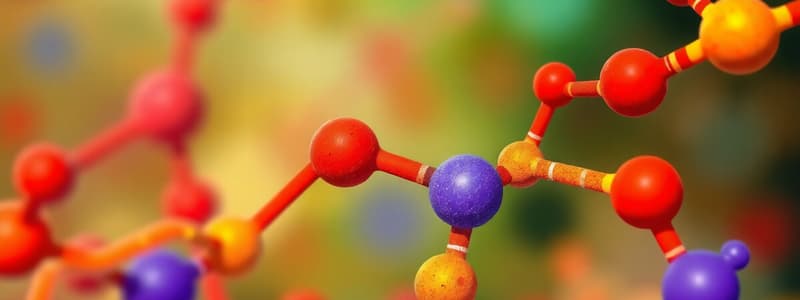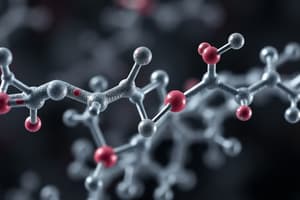Podcast
Questions and Answers
What describes the primary structure of a protein?
What describes the primary structure of a protein?
- The folding of the polypeptide into a specific configuration.
- The linear sequence of amino acids linked by peptide bonds. (correct)
- The overall three-dimensional structure formed by R group interactions.
- The aggregation of multiple polypeptide subunits.
Which structure of a protein is characterized by hydrogen bonds forming a repeating configuration?
Which structure of a protein is characterized by hydrogen bonds forming a repeating configuration?
- Primary structure
- Quaternary structure
- Tertiary structure
- Secondary structure (correct)
How many polypeptide chains are involved in the quaternary structure of collagen?
How many polypeptide chains are involved in the quaternary structure of collagen?
- Three (correct)
- Two
- Four
- Five
What is primarily responsible for the unique three-dimensional shape of a protein's tertiary structure?
What is primarily responsible for the unique three-dimensional shape of a protein's tertiary structure?
Which of the following pairs a type of secondary structure with a corresponding example?
Which of the following pairs a type of secondary structure with a corresponding example?
Which of the following classes of biological molecules are polymers?
Which of the following classes of biological molecules are polymers?
What is the correct term for the reaction that forms polymers from monomers?
What is the correct term for the reaction that forms polymers from monomers?
Which statement about monosaccharides is true?
Which statement about monosaccharides is true?
What distinguishes lipids from the other classes of biological macromolecules?
What distinguishes lipids from the other classes of biological macromolecules?
What type of linkage connects monosaccharides to form disaccharides?
What type of linkage connects monosaccharides to form disaccharides?
Which reaction is the process by which polymers are broken down into monomers?
Which reaction is the process by which polymers are broken down into monomers?
Which of the following statements is FALSE regarding macromolecules?
Which of the following statements is FALSE regarding macromolecules?
What structural role does chitin play in biological organisms?
What structural role does chitin play in biological organisms?
Which statement accurately describes lipids?
Which statement accurately describes lipids?
What are the components of fats?
What are the components of fats?
What distinguishes saturated fatty acids from unsaturated fatty acids?
What distinguishes saturated fatty acids from unsaturated fatty acids?
What is the result of an ester linkage in the formation of fats?
What is the result of an ester linkage in the formation of fats?
Why are lipids considered hydrophobic?
Why are lipids considered hydrophobic?
Which characteristic of unsaturated fatty acids affects their physical state at room temperature?
Which characteristic of unsaturated fatty acids affects their physical state at room temperature?
What type of molecule is primarily formed from the combination of glycerol and three fatty acids?
What type of molecule is primarily formed from the combination of glycerol and three fatty acids?
Which type of lipids is crucial for forming cell membranes?
Which type of lipids is crucial for forming cell membranes?
Which amino acid has a side chain that includes sulfur?
Which amino acid has a side chain that includes sulfur?
Identify the amino acid that is classified as polar.
Identify the amino acid that is classified as polar.
Which of the following amino acids does not have a branched side chain?
Which of the following amino acids does not have a branched side chain?
Which of the following statements about phenylalanine is true?
Which of the following statements about phenylalanine is true?
Select the amino acid known for forming unique cyclic structures.
Select the amino acid known for forming unique cyclic structures.
Which amino acid is not typically associated with the formation of hydrophobic interactions?
Which amino acid is not typically associated with the formation of hydrophobic interactions?
Which amino acid is primarily responsible for the formation of hydrogen bonds in proteins?
Which amino acid is primarily responsible for the formation of hydrogen bonds in proteins?
Which amino acid is considered essential in the human diet, meaning it must be obtained from food?
Which amino acid is considered essential in the human diet, meaning it must be obtained from food?
What distinguishes phospholipids from triglycerides?
What distinguishes phospholipids from triglycerides?
Which of the following correctly describes the function of proteins in a cell?
Which of the following correctly describes the function of proteins in a cell?
What is the role of R groups in amino acids?
What is the role of R groups in amino acids?
Which of the following does NOT describe the structure of phospholipids?
Which of the following does NOT describe the structure of phospholipids?
Which of the following statements is incorrect about cholesterol?
Which of the following statements is incorrect about cholesterol?
What type of bond links amino acids together in a polypeptide?
What type of bond links amino acids together in a polypeptide?
How do soaps and detergents relate to cholesterol and phospholipids?
How do soaps and detergents relate to cholesterol and phospholipids?
Which of the following best describes the components of proteins?
Which of the following best describes the components of proteins?
Why are phospholipids essential for cell membranes?
Why are phospholipids essential for cell membranes?
Flashcards
Macromolecules
Macromolecules
Large molecules composed of thousands of covalently connected atoms.
Polymer
Polymer
A long molecule consisting of many similar building blocks.
Monomers
Monomers
The repeating building blocks that make up polymers.
Dehydration Synthesis
Dehydration Synthesis
Signup and view all the flashcards
Hydrolysis
Hydrolysis
Signup and view all the flashcards
Monosaccharides
Monosaccharides
Signup and view all the flashcards
Polysaccharides
Polysaccharides
Signup and view all the flashcards
Primary Structure
Primary Structure
Signup and view all the flashcards
Secondary Structure
Secondary Structure
Signup and view all the flashcards
Tertiary Structure
Tertiary Structure
Signup and view all the flashcards
Quaternary Structure
Quaternary Structure
Signup and view all the flashcards
Protein Shape and Function
Protein Shape and Function
Signup and view all the flashcards
Chitin
Chitin
Signup and view all the flashcards
N-acetylglucosamine
N-acetylglucosamine
Signup and view all the flashcards
Lipids
Lipids
Signup and view all the flashcards
Fatty acids and glycerol
Fatty acids and glycerol
Signup and view all the flashcards
Glycerol
Glycerol
Signup and view all the flashcards
Fatty acid
Fatty acid
Signup and view all the flashcards
Triacylglycerol (or Triglyceride)
Triacylglycerol (or Triglyceride)
Signup and view all the flashcards
Saturated fatty acid
Saturated fatty acid
Signup and view all the flashcards
Unsaturated fatty acid
Unsaturated fatty acid
Signup and view all the flashcards
Amino Acid
Amino Acid
Signup and view all the flashcards
R-group
R-group
Signup and view all the flashcards
Polar Amino Acid
Polar Amino Acid
Signup and view all the flashcards
Non-polar Amino Acid
Non-polar Amino Acid
Signup and view all the flashcards
Glycine
Glycine
Signup and view all the flashcards
Alanine
Alanine
Signup and view all the flashcards
Valine
Valine
Signup and view all the flashcards
Leucine
Leucine
Signup and view all the flashcards
Isoleucine
Isoleucine
Signup and view all the flashcards
Methionine
Methionine
Signup and view all the flashcards
What are phospholipids?
What are phospholipids?
Signup and view all the flashcards
How do phospholipids form cell membranes?
How do phospholipids form cell membranes?
Signup and view all the flashcards
What are steroids?
What are steroids?
Signup and view all the flashcards
What is cholesterol?
What is cholesterol?
Signup and view all the flashcards
Why are phospholipids and cholesterol amphipathic?
Why are phospholipids and cholesterol amphipathic?
Signup and view all the flashcards
What are proteins?
What are proteins?
Signup and view all the flashcards
What are amino acids?
What are amino acids?
Signup and view all the flashcards
What are polypeptides?
What are polypeptides?
Signup and view all the flashcards
What are some functions of proteins?
What are some functions of proteins?
Signup and view all the flashcards
Why are proteins important?
Why are proteins important?
Signup and view all the flashcards
Study Notes
Biological Molecules Overview
- All living things are made of four major classes of large biological molecules: carbohydrates, lipids, proteins, and nucleic acids.
- Macromolecules are large molecules composed of thousands of covalently bonded atoms.
Polymers and Monomers
- Polymers are long molecules made up of similar building blocks called monomers.
- Carbohydrates, proteins, and nucleic acids are polymers.
- Lipids are not polymers.
Synthesis and Breakdown of Polymers
- Monomers are joined together by condensation reactions (also called dehydration synthesis) that remove a water molecule.
- Polymers are broken down by hydrolysis reactions which add a water molecule.
Carbohydrates
- Carbohydrates serve as fuel and building materials.
- Simple carbohydrates are monosaccharides
- Disaccharides are two monosaccharides joined by a glycosidic linkage.
- Polysaccharides are polymers of monosaccharides.
- Storage polysaccharides include glycogen (animals) and starch (plants).
- Structural polysaccharides include cellulose (plant cell walls) and chitin (exoskeletons of arthropods and fungal cell walls).
Lipids
- Lipids are a diverse group of hydrophobic molecules.
- They do not form polymers.
- Fats are constructed from glycerol and fatty acids (monomers).
- Glycerol is a three-carbon alcohol.
- Fatty acids have a carboxyl group and a hydrocarbon chain.
- In a fat, three fatty acids are attached to glycerol by ester linkages, forming a triacylglycerol (or triglyceride).
- Fatty acids vary in length and the number and location of double bonds.
- Saturated fatty acids have no double bonds.
- Unsaturated fatty acids have one or more double bonds.
- Phospholipids have two fatty acids and a phosphate group attached to glycerol. These are hydrophobic "tails" and a hydrophilic "head"
- Phospholipids form a bilayer in cell membranes.
- Steroids have a carbon skeleton with four fused rings.
- Cholesterol is an important steroid.
Proteins
- Proteins account for more than 50% of the dry mass of most cells.
- Proteins are polymers of amino acids.
- Amino acids have an amino group (NH2) and a carboxyl group (COOH).
- R-groups give unique properties to amino acids.
- Polypeptides are chains of amino acids joined by peptide bonds.
- Protein structure determines function.
- Primary Structure: linear sequence of amino acids.
- Secondary Structure: folding (α-helix and β-sheet) due to hydrogen bonds.
- Tertiary Structure: overall three-dimensional shape stabilized by various interactions between R groups (hydrophobic interactions, hydrogen bonds, disulfide bridges, and ionic bonds).
- Quaternary Structure: multiple polypeptide chains aggregated to form the functional protein (like collagen and hemoglobin).
- Proteins perform a variety of functions (enzymatic, defensive, storage, transport, etc.).
- Denaturation occurs when a protein loses its proper shape due to environmental factors(heat, pH, and chemicals).
- Chaperonins assist in protein folding.
Nucleic Acids
- Nucleic acids store, transmit, and help express hereditary information.
- Genes are the units of inheritance and program protein synthesis.
- Nucleic acids are polymers called polynucleotides, made up of nucleotide monomers.
- Nucleotides have a nitrogenous base, a pentose sugar (deoxyribose or ribose), and one to three phosphate groups.
- Nucleic acids are held together by phosphodiester bonds.
- DNA (deoxyribonucleic acid) is double-stranded, with nitrogenous bases pairing (A-T, G-C).
- RNA (ribonucleic acid) is single-stranded and plays a key role in protein synthesis (contains uracil instead of thymine).
Studying That Suits You
Use AI to generate personalized quizzes and flashcards to suit your learning preferences.




